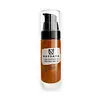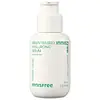What's inside
What's inside
 Key Ingredients
Key Ingredients

 Benefits
Benefits

 Concerns
Concerns

No concerns
 Ingredients Side-by-side
Ingredients Side-by-side

Aloe Barbadensis Leaf Juice
Skin ConditioningWater
Skin ConditioningNiacinamide 3%
SmoothingGlycerin
HumectantAspalathus Linearis Leaf Extract 1.3%
Skin ConditioningCitric Acid
BufferingLysolecithin
EmulsifyingSclerotium Gum
Emulsion StabilisingCannabis Sativa Seed Oil
EmollientSodium Benzoate
MaskingPullulan
Xanthan Gum
EmulsifyingCentella Asiatica Leaf Extract
Skin ConditioningSodium Hyaluronate
HumectantAdansonia Digitata Seed Oil
EmollientPotassium Sorbate
PreservativeTocopherol
AntioxidantArgania Spinosa Kernel Oil
EmollientSodium Phytate
Ubiquinone
AntioxidantGlycine Soja Oil
EmollientSilica
AbrasiveHydroxypropyl Cyclodextrin
MaskingHippophae Rhamnoides Fruit Extract
Skin ConditioningCurcuma Longa Root Extract
MaskingChlorella Vulgaris Powder
Skin ConditioningTetrahydropiperine
Skin ConditioningGlycyrrhiza Glabra Root Extract
BleachingCalendula Officinalis Flower Extract
MaskingPalmitoyl Tripeptide-38
Skin ConditioningAloe Barbadensis Leaf Juice, Water, Niacinamide 3%, Glycerin, Aspalathus Linearis Leaf Extract 1.3%, Citric Acid, Lysolecithin, Sclerotium Gum, Cannabis Sativa Seed Oil, Sodium Benzoate, Pullulan, Xanthan Gum, Centella Asiatica Leaf Extract, Sodium Hyaluronate, Adansonia Digitata Seed Oil, Potassium Sorbate, Tocopherol, Argania Spinosa Kernel Oil, Sodium Phytate, Ubiquinone, Glycine Soja Oil, Silica, Hydroxypropyl Cyclodextrin, Hippophae Rhamnoides Fruit Extract, Curcuma Longa Root Extract, Chlorella Vulgaris Powder, Tetrahydropiperine, Glycyrrhiza Glabra Root Extract, Calendula Officinalis Flower Extract, Palmitoyl Tripeptide-38
Water
Skin ConditioningPropanediol
SolventGlycerin
Humectant1,2-Hexanediol
Skin ConditioningNiacinamide
SmoothingBetaine
HumectantSaccharide Isomerate
HumectantCamellia Sinensis Seed Oil
HumectantXylitol
HumectantCetearyl Olivate
Hydrogenated Lecithin
EmulsifyingButylene Glycol
HumectantSorbitan Olivate
EmulsifyingLactobacillus Ferment Lysate
Skin ConditioningAcrylates/C10-30 Alkyl Acrylate Crosspolymer
Emulsion StabilisingSqualane
EmollientPanthenol
Skin ConditioningAllantoin
Skin ConditioningHydroxyethyl Acrylate/Sodium Acryloyldimethyl Taurate Copolymer
Emulsion StabilisingTromethamine
BufferingEthylhexylglycerin
Skin ConditioningCeratonia Siliqua Gum
EmollientSodium Metaphosphate
BufferingCamellia Sinensis Leaf Extract
AntimicrobialDipotassium Glycyrrhizate
HumectantSodium Hyaluronate
HumectantHyaluronic Acid
HumectantDextrin
AbsorbentTheobroma Cacao Extract
Skin Conditioning3-O-Ethyl Ascorbic Acid
Skin ConditioningSorbitan Isostearate
EmulsifyingSodium Citrate
BufferingCitric Acid
BufferingGlyceryl Oleate
EmollientTocopherol
AntioxidantLecithin
EmollientSucrose
HumectantLauryl Glucoside
CleansingPolyglyceryl-6 Laurate
EmulsifyingMyristyl Glucoside
CleansingXanthan Gum
EmulsifyingLactic Acid
BufferingHydrolyzed Hyaluronic Acid
HumectantSodium Hyaluronate Crosspolymer
HumectantSodium Acetylated Hyaluronate
HumectantWater, Propanediol, Glycerin, 1,2-Hexanediol, Niacinamide, Betaine, Saccharide Isomerate, Camellia Sinensis Seed Oil, Xylitol, Cetearyl Olivate, Hydrogenated Lecithin, Butylene Glycol, Sorbitan Olivate, Lactobacillus Ferment Lysate, Acrylates/C10-30 Alkyl Acrylate Crosspolymer, Squalane, Panthenol, Allantoin, Hydroxyethyl Acrylate/Sodium Acryloyldimethyl Taurate Copolymer, Tromethamine, Ethylhexylglycerin, Ceratonia Siliqua Gum, Sodium Metaphosphate, Camellia Sinensis Leaf Extract, Dipotassium Glycyrrhizate, Sodium Hyaluronate, Hyaluronic Acid, Dextrin, Theobroma Cacao Extract, 3-O-Ethyl Ascorbic Acid, Sorbitan Isostearate, Sodium Citrate, Citric Acid, Glyceryl Oleate, Tocopherol, Lecithin, Sucrose, Lauryl Glucoside, Polyglyceryl-6 Laurate, Myristyl Glucoside, Xanthan Gum, Lactic Acid, Hydrolyzed Hyaluronic Acid, Sodium Hyaluronate Crosspolymer, Sodium Acetylated Hyaluronate
Ingredients Explained
These ingredients are found in both products.
Ingredients higher up in an ingredient list are typically present in a larger amount.
Citric Acid is an alpha hydroxy acid (AHA) naturally found in citrus fruits like oranges, lemons, and limes.
Like other AHAs, citric acid can exfoliate skin by breaking down the bonds that hold dead skin cells together. This helps reveal smoother and brighter skin underneath.
However, this exfoliating effect only happens at high concentrations (20%) which can be hard to find in cosmetic products.
Due to this, citric acid is usually included in small amounts as a pH adjuster. This helps keep products slightly more acidic and compatible with skin's natural pH.
In skincare formulas, citric acid can:
While it can provide some skin benefits, research shows lactic acid and glycolic acid are generally more effective and less irritating exfoliants.
Most citric acid used in skincare today is made by fermenting sugars (usually from molasses). This synthetic version is identical to the natural citrus form but easier to stabilize and use in formulations.
Read more about some other popular AHA's here:
Learn more about Citric AcidGlycerin is already naturally found in your skin. It helps moisturize and protect your skin.
A study from 2016 found glycerin to be more effective as a humectant than AHAs and hyaluronic acid.
As a humectant, it helps the skin stay hydrated by pulling moisture to your skin. The low molecular weight of glycerin allows it to pull moisture into the deeper layers of your skin.
Hydrated skin improves your skin barrier; Your skin barrier helps protect against irritants and bacteria.
Glycerin has also been found to have antimicrobial and antiviral properties. Due to these properties, glycerin is often used in wound and burn treatments.
In cosmetics, glycerin is usually derived from plants such as soybean or palm. However, it can also be sourced from animals, such as tallow or animal fat.
This ingredient is organic, colorless, odorless, and non-toxic.
Glycerin is the name for this ingredient in American English. British English uses Glycerol/Glycerine.
Learn more about GlycerinNiacinamide is a multitasking form of vitamin B3 that strengthens the skin barrier, reduces pores and dark spots, regulates oil, and improves signs of aging.
And the best part? It's gentle and well-tolerated by most skin types, including sensitive and reactive skin.
You might have heard of "niacin flush", or the reddening of skin that causes itchiness. Niacinamide has not been found to cause this.
In very rare cases, some individuals may not be able to tolerate niacinamide at all or experience an allergic reaction to it.
If you are experiencing flaking, irritation, and dryness with this ingredient, be sure to double check all your products as this ingredient can be found in all categories of skincare.
When incorporating niacinamide into your routine, look out for concentration amounts. Typically, 5% niacinamide provides benefits such as fading dark spots. However, if you have sensitive skin, it is better to begin with a smaller concentration.
When you apply niacinamide to your skin, your body converts it into nicotinamide adenine dinucleotide (NAD). NAD is an essential coenzyme that is already found in your cells as "fuel" and powers countless biological processes.
In your skin, NAD helps repair cell damage, produce new healthy cells, support collagen production, strengthen the skin barrier, and fight environmental stressors (like UV and pollution).
Our natural NAD levels start to decline with age, leading to slower skin repair, visible aging, and a weaker skin barrier. By providing your skin niacinamide, you're recharging your skin's NAD levels. This leads to stronger, healthier, and younger looking skin.
Another name for vitamin B3 is nicotinamide. This vitamin is water-soluble and our bodies don't store it. We obtain Vitamin B3 from either food or skincare. Meat, fish, wheat, yeast, and leafy greens contain vitamin B3.
The type of niacinamide used in skincare is synthetically created.
Learn more about NiacinamideSodium Hyaluronate is hyaluronic acid's salt form. It is commonly derived from the sodium salt of hyaluronic acid.
Like hyaluronic acid, it is great at holding water and acts as a humectant. This makes it a great skin hydrating ingredient.
Sodium Hyaluronate is naturally occurring in our bodies and is mostly found in eye fluid and joints.
These are some other common types of Hyaluronic Acid:
Learn more about Sodium HyaluronateTocopherol (also known as Vitamin E) is a common antioxidant used to help protect the skin from free-radicals and strengthen the skin barrier. It's also fat soluble - this means our skin is great at absorbing it.
Vitamin E also helps keep your natural skin lipids healthy. Your lipid skin barrier naturally consists of lipids, ceramides, and fatty acids. Vitamin E offers extra protection for your skin’s lipid barrier, keeping your skin healthy and nourished.
Another benefit is a bit of UV protection. Vitamin E helps reduce the damage caused by UVB rays. (It should not replace your sunscreen). Combining it with Vitamin C can decrease sunburned cells and hyperpigmentation after UV exposure.
You might have noticed Vitamin E + C often paired together. This is because it is great at stabilizing Vitamin C. Using the two together helps increase the effectiveness of both ingredients.
There are often claims that Vitamin E can reduce/prevent scarring, but these claims haven't been confirmed by scientific research.
Learn more about TocopherolWater. It's the most common cosmetic ingredient of all. You'll usually see it at the top of ingredient lists, meaning that it makes up the largest part of the product.
So why is it so popular? Water most often acts as a solvent - this means that it helps dissolve other ingredients into the formulation.
You'll also recognize water as that liquid we all need to stay alive. If you see this, drink a glass of water. Stay hydrated!
Learn more about WaterXanthan gum is used as a stabilizer and thickener within cosmetic products. It helps give products a sticky, thick feeling - preventing them from being too runny.
On the technical side of things, xanthan gum is a polysaccharide - a combination consisting of multiple sugar molecules bonded together.
Xanthan gum is a pretty common and great ingredient. It is a natural, non-toxic, non-irritating ingredient that is also commonly used in food products.
Learn more about Xanthan Gum